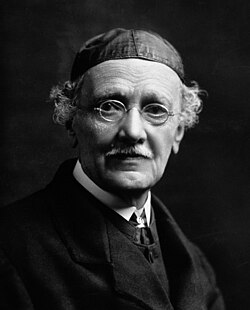
Summary
Sir George Christopher Molesworth Birdwood KCIE CSI LH (8 December 1832 – 28 June 1917) also known as Sir George Birdwood was an Anglo-Indian official, naturalist, and writer. He served as the first Sheriff of Bombay from 1846 to 1858.
George Birdwood | |
|---|---|
 | |
| 1st Sheriff of Bombay | |
| In office 1846 - 1858 | |
| Preceded by | position established |
| Succeeded by | Bomonji Hormusji Wadia |
| Personal details | |
| Born | George Christopher Molesworth Birdwood 8 December 1832 Belgaum, Bombay Presidency, British India |
| Died | 28 June 1917 (aged 85) Ealing, London, United Kingdom |
| Nationality | British Indian |
| Domestic partner | Frances Anne Tolcher |
| Parent(s) | Christopher Birdwood (father) Lydia Juliana Taylor (mother) |
| Alma mater | Plymouth Grammar School Edinburgh University |
| Occupation | Naturalist, writer |
| Awards | Order of the Indian Empire Order of the Star of India Legion of Honour |
Life edit
The son of General Christopher Birdwood, he was born at Belgaum, then in the Bombay Presidency, on 8 December 1832.[1][2] He was educated at Plymouth Grammar School and Edinburgh University, where he took his MD degree presenting the thesis "The origin of ideas".[3] Entering the Bombay Medical Service in 1854, he served in the Persian War of 1856-57, and subsequently became professor at the Grant Medical College, registrar of the university, curator of the museum, and sheriff at Bombay, besides acting as secretary of the Asiatic and Horticultural societies.[2]
Birdwood interested himself also in the municipal life of Bombay, where he acquired influence and popularity. He was obliged by ill-health in 1868 to return to England, where he entered the revenue and statistics department of the India Office (1871–1902).[2]
In the dedication to his English translation of Garcia de Orta's book, Clements Markham calls Birdwood the "Garcia da Orta of British India".[4] He kept up his connection to India with contributions to the Indian press; and established longterm friendships with Indian princes and educated Indians. In 1846 he was selected Sheriff of Bombay[5] In 1887 he was created a Knight Commander of the Order of the Indian Empire; and, besides being given his Doctor of Laws degree by the University of Cambridge, he was also made an officer of the Légion d'Honneur and a laureate of the French Academy.[2]
While chairing the Indian Section of the annual meeting of the Royal Society of Arts in 1910, Birdwood declared that there was no "fine art" in India. When a particular statue of the Buddha was adduced as counter-example, Birdwood is said to have responded: "This senseless similitude, in its immemorial fixed pose, is nothing more than an uninspired brazen image. . . . A boiled suet pudding would serve equally well as a symbol of passionless purity and serenity of soul."[6]
Birdwood died in Ealing on 28 June 1917.[7]
Works edit
- The Economic Vegetable Products of the Bombay Presidency (12th edition, 1868)[2]
- On the Genus Boswellia [Frankincense Trees] (1870)
- The Industrial Arts of India (1888)
- Reports on the Old Records of the India Office (1891)
- The Register of Letters and of the Governor and Company of Merchants of London Trading into the East Indies 1600-1619 (1893) with Sir William Foster
- First Letter Book of the East India Company (1895)
Birdwood published on the industrial arts of India, the ancient records of the India Office, and the first letter-book of the East India Company. He encouraged Indian arts, on various aspects of which he wrote monographs, and his name was identified with the representation of India at the major International Exhibitions from 1857 to 1901.[2][9] His researches on the subject of incense,[10] became a classic.[2]
When still young, Birdwood contributed to magazines and newspapers; in India he helped to convert the Standard into The Times of India, and edited the Bombay Saturday Review; and after his return to London he wrote for the Pall Mall, Athenaeum, Academy, and The Times; and with Thomas Chenery, the editor of The Times, and others he took the initiative (1882) in celebrating the anniversary of Lord Beaconsfield's death as Primrose Day (19 April).[2]
Notes edit
- ^ Head, Raymond (1988). "Indian Crafts and Western Design from the Seventeenth Century to the Present". RSA Journal. 136 (5378): 121–122. ISSN 0958-0433. JSTOR 41374508.
- ^ a b c d e f g h Chisholm 1911.
- ^ Birdwood, George Christopher Molesworth (1854). "The origin of ideas".
{{cite journal}}: Cite journal requires|journal=(help) - ^ Clements R. Markham (1913). Colloquies on the simples and drugs of India by Garcia da Orta. London: Henry Sotheran and Co.
- ^ Dictionary of Indian Biography. p. 43.
- ^ Mark Sedgwick, Against the Modern World: Traditionalism and the Secret Intellectual History of the Twentieth Century, Oxford University Press, 2004, page 52. ISBN 978-0-19-515297-5.
- ^ Chisholm, Hugh, ed. (1922). "Birdwood, Sir George Christopher Molesworth". Encyclopædia Britannica. Vol. 30 (12th ed.). London & New York: The Encyclopædia Britannica Company. pp. 456–457.
- ^ International Plant Names Index. Birdw.
- ^ Journal of Indian Art, vol. viii. The Life and Work of Sir George Birdwood
- ^ Trans. Liun. Soc. xxvii., 1871; Ency. Brit. 9th ed., Incense, 1881; revised
References edit
- This article incorporates text from a publication now in the public domain: Chisholm, Hugh, ed. (1911). "Birdwood, Sir George Christopher Molesworth". Encyclopædia Britannica. Vol. 3 (11th ed.). Cambridge University Press. p. 979.
Further reading edit
George Christopher Molesworth Birdwood
- Rao, C. Hayavadana, ed. (1915). "Birdwood, Sir George Christopher Molesworth". The Indian Biographical Dictionary.
- Cooper, Thompson, ed. (1884). "Birdwood, George Christopher Molesworth". Men of the Time (eleventh ed.).


